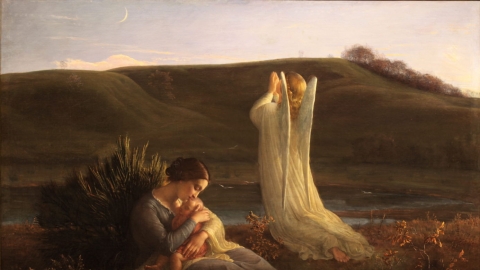Inscription of the Name of a Swiss Hero Discovered in Jerusalem

Israel Antiquities Authority stated on Thursday, October 20, that a medieval inscription bearing the name of a Swiss knight has been discovered on a wall in the Cenacle on Mount Zion in Jerusalem. A charcoal etching with the heraldic emblem of the family of Adrian von Bubenberg (1424-1479) has been revealed by recent techniques.
The discovery by archaeologists working on Mount Zion was made as part of a project by the Antiquities Authority at the King David’s Tomb Complex that focuses on documenting old graffiti and ancient inscriptions left on the walls by Christian and Muslim pilgrims.
The project has so far revealed more than 40 inscriptions in different languages and family emblems of medieval knights.
“In the Mamluk period, between 1332-1551, the building complex adjacent to the traditional tomb of King David was owned by the Monks of the Franciscan Catholic Order. The building served as a monastery and hostel for Western pilgrims, who left their mark on the walls,” said project leaders Michael Chernin and Shai Halevi of the Israel Antiquities Authority.
“These new discoveries were made possible thanks to new technological capabilities developed by the Antiquities Authority as part of research conducted on the Judean Desert scrolls (at the Qumran site). The method uses multispectral photography to bring to light inscriptions that have been faded over the years and have become invisible to the human eye.”
Among the revealed inscriptions is a charcoal inscription bearing the name and heraldic emblem of von Bubenberg’s family. A 15th-century Swiss soldier and politician, Adrian von Bubenberg was dubbed a Knight of the Holy Sepulchre in Jerusalem when he came to the Holy Land.
In 1469, he went to the Ranft to attest to the authenticity St. Nicholas of Flue’s fasting (living only on the Eucharist). Head of an old and eminent house, he was appointed in 1470-1471 as spokesman for the Bernese nobility in the affair of the vigilante lords.
Diplomatic missions took him to Savoy, Burgundy, and the Empire. During the months preceding the Burgundian Wars (1474-1477), he resolutely opposed the offensive alliance with the King of France, which led to him being expelled from the Petit Conseil on July 10, 1475 with a ban on engaging in any political activity.
Nevertheless, in April 1476 he put in charge of defending the city of Morat, which resisted a twelve-day siege before the Battle of Morat, on June 22, 1476, which saw the defeat of the Burgundians and the victory of the Swiss Confederation. Adrian von Bubenberg is considered a national hero: many streets bear his name and a statue of him was erected on a square in the city of Bern.
However, there remains a doubt: the Antiquities Authority recalled that his son Adrian (II) von Bubenberg was also known to have visited Jerusalem and that it is impossible to know with certainty whether this inscription refers to either the son or father.
(Sources : cath.ch/Times of Israel/Dictionnaire historique de la Suisse – FSSPX.Actualités)
Illustration : © Shai Halevy, Israel Antiquities Authority





